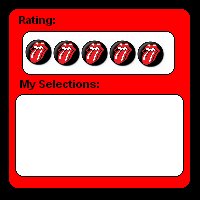So I’ve dragged the first five Stone albums into my life. Not really sure where I’ve wanted to take this blog --I’ve gone from a moderately interesting personal account of how their music was influencing my life, to an unfortunately academic seeming structure where I summarize their albums in a rather discouraging drawn-out fashion. Most gross and grim this is to me, as meager amusing adjectives are the sole personal flare I get to squeeze-in edgewise in these rather un-intense “intense reviews”. While I find these bombastic summaries most useful to someone who’ll never listen to these albums, I’m rather selfish and have little aspiration to satisfy others at my displeasure. The only gratification I derive from having these “intense reviews” frantically fleeing from my faculty come in the form of a contorted hope that some debilitated future-self, after escape from rehab –or some institution of brainwashing, will feel compelled to find out what some pablum previous-self was dolefully indulging in. With that said, I think it’s of utmost importance that I drag on in this way –of course, exclusively for the appeasement of others… So after robotically tripping through a rundown of five structured album reviews I plan to let loose with a little attitude and shoot-it about how the Stone’s music is meshing with my life while injecting little tidbits of history about the band.
As the Rolling Stones produced their music it was released in the UK and the US on albums that were similar but not the same. As of this far, I have delved merely into the American releases and have neglected to reveal the intact group dynamics of the Stones.
were similar but not the same. As of this far, I have delved merely into the American releases and have neglected to reveal the intact group dynamics of the Stones.
Mick Jagger, and Keith Richards I’ve touched on extensively with their lead vocals and guitar respectively but I’ve severely underestimated the talent that Brian Jones brought to the band. He possessed the communicative talent of being able to play nearly every instrument. Bill Wyman occupied the bass guitar, and Charlie Watts hammered eloquently on the drums.
There are only so many ways to incorporate music into my life. While the majority of the masses drone through time plugged into i-pods and chattering away on cell-phones with musical ring-tones --these are things I refuse to do. The greater part of my listening takes place while I lounge around my room, looking over school readings, kickin’ it with my 17 year old dog. Beyond that, there’s always my car, my CD player alarm clock and occasionally I’ll plug in for a fast-paced jog.
The music of the Stone’s is sexier –more jive than the kind of music you’re supposed to be listening to with your decaying Yorkshire terrier. The soul that’s in Mick Jagger’s spasmic, rhythmic dancing as he sings --embodies something more demonic, anxious, vibrant and alive than reading Dickens, Aphra Behn, or the T.S. Elloit’s The Waste Land…well maybe not The Waste Land….
The Rolling Stone’s music takes on their lifestyle during that time --Jagger, Richards and Jones spending a night in the slammer for drug related charges during July of ‘67. This is the kind of music that should come alive within the city of Windsor. The City of Windsor: home of a wild and howling night-life --from the student ghetto to a thriving bar-scene. Allen Ginsberg in response to their conflict with the law stated: “The Rolling Stones are one of Britain’s major cultural assets, who should be honoured by the kingdom instead of jailed.” This is a kind of music that screams to be synonymously linked with the idea of freedom. And being fettered with five English classes this semester I cannot give this music the true listening it deserves. Nor can my Yorkshire terrier, but that’s because she’s deaf.
 what he likes best at that very moment. However, this album is a compilation of tracks and it draws heavily on material that I’ve already given much time and consideration to in the past few weeks. In short, I’ve been rather guiltly of grazing through this album in search green pastures of unheard music. And through the use of these cow-like listening techniques I’m not surprised to find that I’ve found little enjoyment here. In all fairness I think in the future I might look back on this album and think it deserves higher esteem.
what he likes best at that very moment. However, this album is a compilation of tracks and it draws heavily on material that I’ve already given much time and consideration to in the past few weeks. In short, I’ve been rather guiltly of grazing through this album in search green pastures of unheard music. And through the use of these cow-like listening techniques I’m not surprised to find that I’ve found little enjoyment here. In all fairness I think in the future I might look back on this album and think it deserves higher esteem. riff from a twelve-string guitar that gives the tune a cold and unusual vibe.
riff from a twelve-string guitar that gives the tune a cold and unusual vibe.









